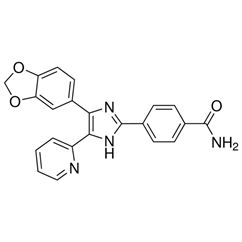Recombinant Human FGF-6

Induced proliferation of NR6R-3T3 cells assay for Human FGF-6. Cell proliferation was measured to calculate the ED50, which is as expected less than 1 ng/ml.

Non-reducing (-) and reducing (+) conditions in a 4 - 20% Tris-Glycine gel stained with Coomassie Blue. 1 μg of protein was loaded in each lane. Human FGF-6 has a predicted Mw of 18.9 kDa.
Achieve Purchasing Synergy
Request a quote at [email protected] for 2 or more vials of any Growth Factor to receive a discount. Discounts range from 5 to 20% according to the size of your order.
PODS® Growth Factors
The product is currently not available as PODS®, please check back in the future.Description
Fibroblast Growth Factor 6 (FGF-6) is a heparin-binding growth factor that is expressed in epithelial and mesenchymal lineages. FGF-6 binds and signals through the FGF receptors FGFR1, FGFR2, and FGFR4. FGF-6 functions as a mitogen for vascular endothelial cells and fibroblasts. FGF-6 is also an important factor driving muscle differentiation and regeneration.Activity Assay
Human FGF-6 is fully biologically active when compared to standard. The activity is determined by the dose-dependent induced proliferation of NR6R-3T3 cells with 1 μg heparin and it is typically less than 1 ng/ml. This corresponds to an expected specific activity of 1.0 x 106 units/mg.AA Sequence
MGTRANNTLL DSRGWGTLLS RSRAGLAGEI AGVNWESGYL VGIKRQRRLY CNVGIGFHLQ VLPDGRISGT HEENPYSLLE ISTVERGVVS LFGVRSALFV AMNSKGRLYA TPSFQEECKF RETLLPNNYN AYESDLYQGT YIALSKYGRV KRGSKVSPIM TVTHFLPRIAlternative Names
Fibroblast Growth Factor 6, FGF6, FGF 6, heparin secretory-transforming protein 2, HST-2, HSTF-2, heparin-binding growth factor 6, HBGF-6| Product Details | |
|---|---|
| Length | 169 aa |
| Molecular Weight | 18.9 kDa |
| Structure | Monomer |
| Source | E. coli |
| Accession Number | P10767 |
| Purity | ≥95% determined by reducing and non-reducing SDS-PAGE |
| Endotoxin Level | ≤1.00 EU/μg as measured by kinetic LAL |
| Formulation | Lyophilized from a sterile (0.2 micron) filtered aqueous solution containing 10 mM sodium phosphate, 50 mM sodium chloride, pH 7.5 |
| Reconstitution | Centrifuge vial before opening. When reconstituting the product, gently pipet and wash down the sides of the vial to ensure full recovery of the protein into solution. It is recommended to reconstitute the lyophilized product with sterile water at 0.1 mg/ml, which can be further diluted into other aqueous solutions. If a precipitate is observed, centrifuge the solution thoroughly and use only the soluble fraction (removing it from the precipitate). A 10% overfill has been added to compensate for any loss of protein in the precipitate. |
| Stability and Storage |
12 months from date of receipt when stored at -20°C to -80°C as supplied. 1 month when stored at 4°C after reconstituting as directed. 3 months when stored at -20°C to -80°C after reconstituting as directed. |






